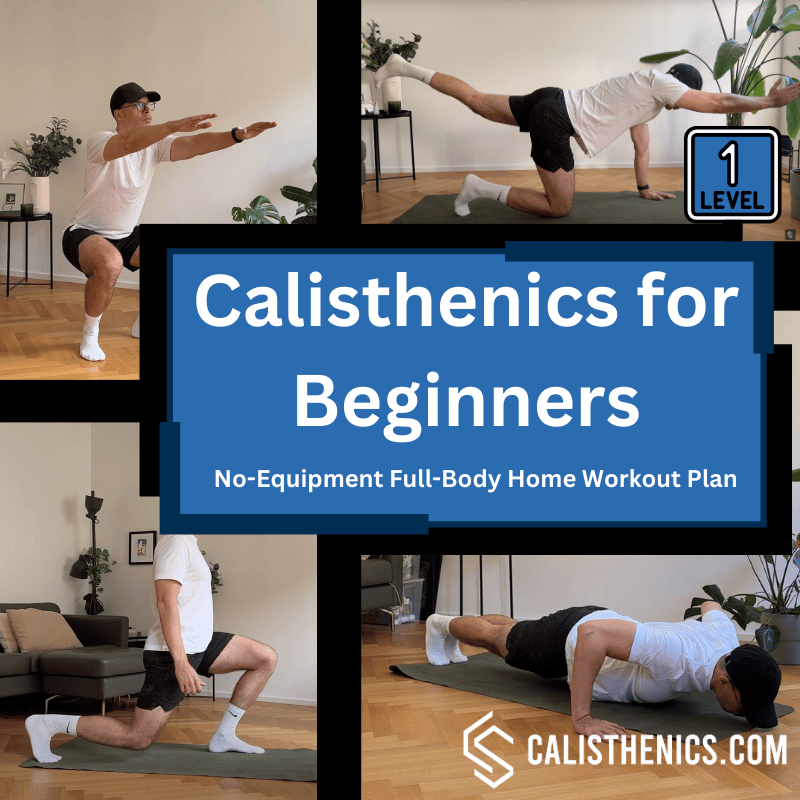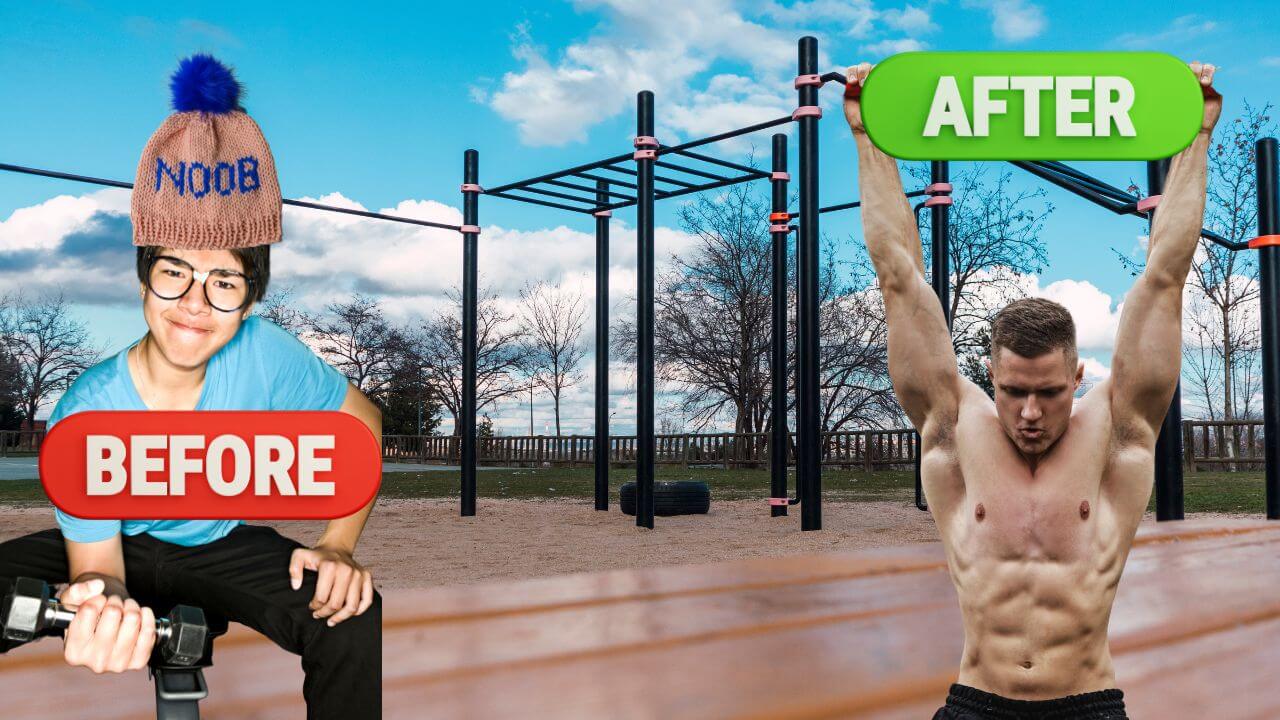Calisthenics is an over two thousand years old discipline, founded in Greece. It was used to train the ancient Greek and Spartan militaries. Much later it was adopted by the Europeans, then the American cultures, and it still forms the basis for military training around the world.
Calisthenics is a form of bodyweight training that is based on natural movement. Includes exercises like push up, pull up and squats, as well as more advanced movements like muscle up, front lever, back lever, and handstand push up. Calisthenics improves our functional strength and ability to hold, push, and pull. Most exercises can be performed at home with no or minimal equipment.
In another article I compared why calisthenics can be better than weight training.
Tips for Maximizing Your Progress in Calisthenics
The beauty of calisthenics is that there are so many ways one can practice it. Some train to be able to swing and jump on bars. Others just want to get more flexible and stronger to improve their functional fitness so they can enjoy everyday life more.
Calisthenics is also great as supplementary training to improve performance in other sports disciplines. For example there are scientifically proven benefits of calisthenics for both 🏃 runners and 🚴 cyclists.
Regardless of your goal and current fitness level, even the most impressive athletes started out without being able to do a single pull-up. You just have to decide that you want to do it and make a plan. Once you know the basics, you are ready to start your first full-body calisthenics workout for beginners or create your own calisthenics workout plan from scratch.
To safely start calisthenics it’s important to build solid foundational strength and to understand some of the basic concepts of bodyweight training:
Get the Right Equipment
When I first started calisthenics, I believed the beauty of it was its simplicity—you could work out almost anywhere with just your body. And while that’s absolutely true, over time, I realized that having the right equipment can make a world of difference.
Essential tools like a pull-up bar, parallettes, and resistance bands can open up a variety of exercises and progressions that simply aren’t possible without them. Rings, for example, are a versatile addition that allow for pushing and pulling movements, as well as advanced skills like muscle-ups or levers.
You can check out my article where I list the ▶️ best calisthenics equipment.
Get the Right Advice
One of the biggest challenges I’ve faced in learning calisthenics is sifting through the mountain of bad advice that’s everywhere on Instagram and YouTube. Don’t get me wrong, there’s a lot of great information out there, but for every helpful tip, there are ten more that could set you back—or worse, get you injured. I’ve seen fitness influencers promote flashy moves they clearly aren’t qualified to teach or push routines that look cool but are completely unrealistic for beginners. It can be frustrating, especially if you’re just starting out and don’t know what’s legit.
The problem is that anyone can post content online, and popularity doesn’t always equal expertise. Just because someone has a six-pack and thousands of followers doesn’t mean they know how to guide others safely and effectively. I’ve made the mistake of trying routines I found online without understanding the underlying principles, and let me tell you—it wasn’t worth it. I ended up wasting time on things that didn’t help me progress and sometimes left me feeling discouraged or dealing with nagging aches.
That’s why I’ve learned to be super selective about where I get my information. Instead of scrolling through random social media accounts, I recommend sticking to trusted resources, like:
- the 📱 best calisthenics apps or
- 📚 foundational calisthenics books written by actual experts.
Apps can be great because they often provide structured programs tailored to your level, and books can give you a deeper understanding of the “why” behind the movements. Both are far more reliable than chasing trends from influencers trying to go viral.
Progressive Overload is the Essence of Growth
Progressive overload is the heart and soul of making progress in calisthenics. It’s the principle that you need to consistently challenge your body with a little more than it’s used to if you want to get stronger, build muscle, or improve endurance. Without it, you’re just spinning your wheels, doing the same thing over and over without actually improving. Whether you’re a total beginner or an advanced athlete, this concept applies across the board.
In calisthenics, progressive overload doesn’t always mean adding weight like in traditional weightlifting. Instead, it can look like
- increasing the number of reps,
- improving your range of motion,
- slowing down your tempo for more time under tension, or
- moving to a harder variation of an exercise.
For example, once push-ups on your knees become easy, you might progress to full push-ups, then diamond push-ups, and eventually archer push-ups. Each step builds on the last, forcing your body to adapt and grow stronger.
The beauty of progressive overload is that it keeps things challenging and exciting while ensuring consistent improvement. Without it, your body gets too comfortable, and your progress plateaus. The key is to listen to your body and progress at a pace that’s right for you—pushing hard enough to challenge yourself but not so much that you risk injury. By keeping this principle at the center of your training, you’ll see steady, measurable results, no matter where you’re starting from.
Start with Full-Body Workouts if You're a Total Beginner
For beginners, it's recommended to prioritize full-body workouts over say split training. If you are just starting out, chances are that your muscles, connective tissue, and joints are unbalanced and unprepared for a large impact. But we usually don't know where these imbalances are exactly. The first objective should be to develop overall strength and flexibility so the body gets used to the increased demand.
In addition, when you do full-body workouts you will target the same muscle groups more frequently. This way they will get stronger at a faster rate given enough rest time. This is because the rate of progress is usually faster and more visible for beginners.
You can browse our ▶️ workout plans library or start right away with our Level 1 workout plan below:

- Designed for total beginners
- Short and efficient workouts (30-40min)
- All exercises doable at home with no equipment
- 4-week program with 12 workout sessions
- Great variety of 40+ exercises
- Exercise videos and detailed guides included
Train at Least 2x, But No More Than 5x Per Week
As elaborated in the previous point, the higher frequency will promote faster progress. Make sure you rest one day after each workout.
Take for example a simple push-up where you perform the exercise by putting your hands on an elevated surface - the higher your hands are the easier the exercise will become. If you want to make the regular push-up more difficult, you will elevate your feet - the higher the feet are compared to your hand position, the more difficult it will get.
Adjusting difficulty in calisthenics is a bit more complicated compared to weight training. Instead of adding a plate or two on the bar you need to learn to leverage gravity. Changing your body's position will also make the same exercise more challenging.
This is the basis for increasing strength and muscle mass. It basically means that as our body gets used to a certain load we gradually increase the stress on the muscular and nervous system which results in adaptation aka. growth of muscle and increase in strength. In calisthenics terms, it would mean that after mastering a certain form of exercise we move on to a harder version of that exercise.
Focus on One Skill at a Time
You may have been drawn to calisthenics by seeing some impressive-looking exercises. In the beginning, don’t overcomplicate your workouts with creative moves you see on social media. First, learn the essential movements like push up, pull up, dip, and squat along with the core and shoulder isolation exercises. This will build a foundational strength that will help you with the next-level exercises. Stick to the basics.
Learn the Basic Exercises Properly First
Learning the foundational exercises first is absolutely essential in calisthenics because they’re the building blocks of everything else you’ll do. Movements like push-ups, pull-ups, squats, planks, and dips might seem basic, but they’re fundamental for developing the strength and body awareness you’ll need to progress.
Mastering the basics also gives you the opportunity to perfect your form and understand how your body moves. These foundational exercises teach you to engage your core, stabilize your joints, and maintain proper alignment, all of which are crucial for avoiding bad habits. Once you’ve nailed the fundamentals, you’ll find it much easier to transition into harder progressions like muscle-ups, levers, or handstands. Think of it as building a house: if you don’t have a solid foundation, everything else will eventually crumble. Start with the basics, stay consistent, and the rest will fall into place.
During the learning phase, it’s fine to do partial range or “half reps” but the goal is to progress toward full ROM.
Use Full Range of Motion (ROM)
When you’re starting out in calisthenics, it’s tempting to focus on cranking out as many reps as possible or mastering advanced moves right away. I get it—progress feels exciting, and we all want to level up quickly. But one of the most important things you can do as a beginner is to prioritize using a full range of motion (ROM) in every exercise. Trust me, this one small tweak can make a huge difference in how quickly and effectively you build strength, flexibility, and control.
Using a full range of motion means moving your joints through their entire natural range during each rep—like going all the way down in a push-up or fully extending your arms in a pull-up. This might feel harder at first because it demands more strength and control, but it’s worth it. Full ROM not only helps you build muscle more evenly but also ensures you’re developing functional strength that translates to real-life movements. Plus, it sets a strong foundation for harder calisthenics skills down the line, like muscle-ups or handstand push-ups.
I’ve seen so many beginners shortchange their progress by doing half-reps or rushing through exercises just to hit higher numbers. While sometimes this is acceptable (in case of limited mobility, after injury or for seniors) generally by taking your time to master the basics with full ROM, you’re investing in long-term progress. Sure, your rep count might be lower at first, but the strength and mobility you build will pay off tenfold as you advance. Start slow, stay consistent, and don’t be afraid to leave your ego at the door—it’s all part of the journey.
Focus on Strict Movements
If you can only do 1 rep from a certain exercise, it's still OK. Make it part of your strength routine and increase the number of sets and the rest time. For example, you do 10 sets of 1 rep and rest 2 minutes in between. If your goal is to work on muscle growth, you will need to decrease the difficulty of the exercise by moving down on the progression chart so you can perform at least 5 reps in a set.
It's always better to do 5 repetitions correctly than trying to pump out 8 reps in a bad form. Why? Because this way you will stimulate optimal muscle recruitment while at the same time increasing time under tension.
Correct execution of movements is always more important than the number of repetitions you are able to do. Aim to do every exercise in a good form in order to maximize muscle engagement and minimize the risk of injury.
Form Over Volume
In calisthenics, proper form is non-negotiable. Sure, it might be tempting to chase higher rep counts or cram in more sets to feel like you’re making progress, but if your form breaks down, you’re only cheating yourself. Training with poor form not only reduces the effectiveness of the exercise but also increases your risk of injury. No one wants to sideline their progress with a preventable strain or tweak because they were rushing through a workout.
Focusing on form over volume ensures that you’re targeting the right muscles and building balanced strength. Quality always trumps quantity in calisthenics. For example, a clean set of push-ups with full range of motion and proper alignment does far more for your strength and mobility than 30 sloppy half-reps. Plus, good form lays the foundation for mastering more advanced moves down the line. Progressing with solid technique means you’ll build confidence, avoid bad habits, and ultimately achieve more in your training. Remember: it’s not about how much you do—it’s about how well you do it.
Recovery is as Important as Training Itself
The most important components of recovery are rest, sleep, and nutrition.
- Rest: After each training day try to allow one rest day. You can still do some low-intensity exercise (e.g. walking, cycling) or mobility work on these days too.
- Sleep: The most important part of the recovery. Try to sleep at least 7 hours.
- Nutrition: it will depend on whether you want to lose weight or gain muscle. In general, having a diet high in protein and fiber and low in sugar will be beneficial in most cases.
Increase Volume Before Increasing Intensity
For beginners in calisthenics, focusing on increasing volume rather than intensity is one of the best ways to build a strong foundation. Volume, which refers to the total number of reps and sets, allows you to practice the movement more frequently, reinforcing good form and improving muscular endurance. This repetition is crucial because it helps beginners develop the strength needed to execute exercises properly. By gradually increasing volume, you give your body the time it needs to adapt without overloading it, which reduces the risk of injury and burnout.
On the other hand, increasing intensity too soon—like attempting advanced progressions before mastering the basics—can often lead to poor form and unnecessary strain on your muscles and joints.
As a beginner, your priority should be building consistent habits and learning to control your body through foundational movements. Increasing volume lets you train in a way that is challenging but still manageable, so you can progress safely.
Over time, as your volume increases and your technique improves, you’ll naturally be ready to transition to more intense variations without compromising safety or progress.
If You Get Stuck Use Negatives (Eccentric Exercises)
Eccentric exercises are one of the most effective ways to build strength and overcome plateaus. Negatives focus on the lowering phase of a movement, where your muscles are lengthening under tension. This phase is not only easier to control but also allows you to handle more resistance than you can during the lifting (concentric) phase. For example, if you can’t perform a full pull-up yet, lowering yourself slowly from the top position builds the specific muscles and motor patterns required for the full movement. By incorporating negatives into your training, you gradually increase strength and confidence in a controlled and scalable way, helping you bridge the gap to harder progressions.
Build Strong Shoulders and Wrists to Avoid Injury
Building strong shoulders and wrists is crucial in calisthenics because these areas play a foundational role in nearly every upper-body movement. Your shoulders are involved in pushing, pulling, and stabilizing exercises, making them essential for both basic moves like push-ups and advanced skills like handstands or planches. Strong, stable shoulders not only improve performance but also help prevent injuries, which can be common when repeatedly placing weight on your arms during bodyweight exercises.
Similarly, your wrists bear significant loads in many calisthenics movements, especially in pushing exercises and skills that require weight-bearing on your hands, like planks or handstands. Weak wrists are a common limiting factor and can lead to pain or discomfort, halting progress. Strengthening your wrists and improving their mobility ensures they can handle the demands of calisthenics while reducing the risk of strain.
By incorporating specific exercises, like wrist push-ups, scapular drills, or controlled shoulder presses, you create a solid foundation that supports your overall performance and longevity in training.
Build a Strong Core to Master Skills Faster
A strong core is absolutely vital for calisthenics because it provides the stability and control needed for almost every movement. Whether you’re holding a plank, performing pull-ups, or working on advanced skills like levers or handstands, your core acts as the foundation that connects and stabilizes your entire body. A weak core can lead to poor form, making exercises less effective and increasing your risk of injury, especially in your lower back.
Beyond stability, a strong core helps you generate power and maintain proper alignment, which is critical for progressing to more advanced moves. In calisthenics, where body control is everything, a strong core isn’t just helpful—it’s essential for unlocking your full potential.
Practice Mobility Training Regularly
Regularly practicing mobility is essential in calisthenics because it improves your range of motion, allowing you to perform exercises with better form and efficiency. Many calisthenics movements, like deep squats, push-ups, or handstands, require significant joint flexibility and control to execute correctly. Without adequate mobility, your body compensates with poor alignment, which not only limits your progress but also increases the risk of injury. For instance, tight shoulders or hips can prevent you from achieving the full range of motion needed for exercises like dips or lunges, reducing their effectiveness.
Conclusion
The whole point of bodyweight strength training is to enhance the body's natural abilities. By acquiring strong foundations you will be able to avoid injuries and build a strong physique. Don't forget that the key to success is consistency so make sure you never skip a workout because of laziness!




